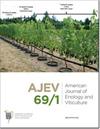Effects of Elevated Atmospheric Carbon Dioxide on the Vineyard System of Vitis vinifera: A Review
IF 1.8
3区 农林科学
Q3 BIOTECHNOLOGY & APPLIED MICROBIOLOGY
引用次数: 1
Abstract
Global atmospheric carbon dioxide concentrations will continue increasing throughout the next century, with profound effects on agriculture. The literature concerning the effects of climate change on viticulture has largely focused on the isolated effects of variables such as temperature and soil water deficit. Likewise, the research on the effects of elevated atmospheric CO2 on grapevines is stunted at the categorical level, chiefly because of the difficulty of experimentally controlling the gaseous environment in situ for the years necessary to replicate the vineyard system in a future climate condition. Despite numerous studies on the short-term influence of environmental and cultural factors on grapevine development at elevated CO2, the long-term effects remain poorly understood. The lack of field based elevated CO2 experiments in the United States is an added challenge to predicting viticultural changes, particularly in California. This review focuses on the systemic effect of atmospheric CO2 on Vitis vinifera, synthesizing physiological, phenological, and plant-pest interactions. Major findings from this synthesis inform of a predicted increase in pest pressure, advanced phenological timing, transient increase in water use efficiency for grapevine, and changes in grape berry chemistry. While water use efficiency is highly desirable, the prediction for current winegrape growing regions is a transient increase in water use efficiency subsequently limited by a lack of available soil water. Grapevine is influenced by the negative synergistic effects of heat, drought, and elevated CO2, which will alter cultural practices including harvest and pest and disease control, with downstream effects on winemaking. Several options for adaptation are discussed including leaf removal, planting alternative varieties, and selective breeding of new varieties.大气二氧化碳浓度升高对葡萄葡萄园系统的影响
全球大气中的二氧化碳浓度将在下个世纪继续增加,对农业产生深远影响。关于气候变化对葡萄栽培影响的文献主要集中在温度和土壤水分亏缺等变量的孤立影响上。同样,关于大气中二氧化碳浓度升高对葡萄树影响的研究在分类水平上受到阻碍,主要是因为在未来气候条件下复制葡萄园系统所必需的多年实验控制气体环境的困难。尽管有大量研究表明环境和文化因素在二氧化碳浓度升高的情况下对葡萄生长的短期影响,但长期影响仍知之甚少。美国缺乏基于田间的二氧化碳升高实验,这对预测葡萄栽培变化是一个额外的挑战,尤其是在加州。本文综述了大气CO2对葡萄(Vitis vinifera)生理、物候和病虫害相互作用的影响。该综合研究的主要发现包括虫害压力的预测增加、物候时间的提前、葡萄植株水分利用效率的短暂提高以及葡萄果实化学成分的变化。虽然水利用效率是非常理想的,但对当前酿酒葡萄种植区的预测是水利用效率的短暂提高,随后受到可用土壤水缺乏的限制。葡萄藤受到高温、干旱和二氧化碳升高的负面协同效应的影响,这将改变包括收获和病虫害控制在内的文化习俗,并对酿酒产生下游影响。讨论了几种适应方法,包括除叶、种植替代品种和选育新品种。
本文章由计算机程序翻译,如有差异,请以英文原文为准。
求助全文
约1分钟内获得全文
求助全文
来源期刊

American Journal of Enology and Viticulture
农林科学-生物工程与应用微生物
CiteScore
3.80
自引率
10.50%
发文量
27
审稿时长
12-24 weeks
期刊介绍:
The American Journal of Enology and Viticulture (AJEV), published quarterly, is an official journal of the American Society for Enology and Viticulture (ASEV) and is the premier journal in the English language dedicated to scientific research on winemaking and grapegrowing. AJEV publishes full-length research papers, literature reviews, research notes, and technical briefs on various aspects of enology and viticulture, including wine chemistry, sensory science, process engineering, wine quality assessments, microbiology, methods development, plant pathogenesis, diseases and pests of grape, rootstock and clonal evaluation, effect of field practices, and grape genetics and breeding. All papers are peer reviewed, and authorship of papers is not limited to members of ASEV. The science editor, along with the viticulture, enology, and associate editors, are drawn from academic and research institutions worldwide and guide the content of the Journal.
 求助内容:
求助内容: 应助结果提醒方式:
应助结果提醒方式:


